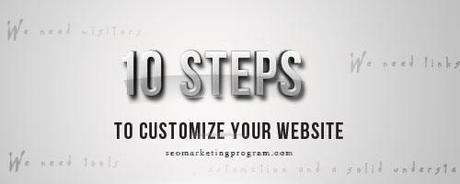We need visitors. We need links. We need tools, automation and a solid understanding of optimization techniques that work today to compete with others.
I’m about to tell you everything that you need to know about how to customize your website here with simple 10 steps.

10 Steps To Customize Your Website
1) Your Meta Description:
Think of your meta-description as an ad, a reason why to click through to your site when people see it in the SERP’s. Google doesn’t care what it says; they DO care about how many clicks it attracts. The more clicks, the more relevance your site holds in Google’s eyes. Increase your CTR in the SERP’s by improving your titles and meta-descriptions, and you can see improved rankings in less than a week.
2) Duplicate Content:
I can tell you that duplicate content penalties aren’t a myth. And that spinning articles is becoming less and less effective. Some duplicate content is okay, especially if your source is the original. If you must have duplicate content, make sure that at least 70% of your site is unique, high-quality content.
3) Include Images And Videos:
This not only improves user engagement, it can also bring in traffic for you. Be sure to use relevant “alternate text” with every image on your page.
4) The Click Through Mentality:
This is another mindset thing, but it’s VERY important. Whether you’re talking about the title of your pages, your meta-data or your internal links, you ALWAYS want the end goal to be a click. And you want that click to deliver on the promise it’s making.
5) There are two types of clicks, and you need to deliver on both promises.
The “Content” Click: contextual link may be “Click here for my post on becoming an SEO rock-star”. You’d have that linked contextually, and you’d deliver on the promise with a quality article on the topic. This gets people both clicking your links AND because you’re delivering what you promise, it greatly improves your average visitors time on site and reduces your bounce rate. This is HUGE when it comes to trust and relevancy.
The “Action” Click: This is when you want them to take a specific action, such as “Get Exclusive Subscriber Updates – Click Here To Sign Up For My FREE Newsletter” or “Click Here To Start Your Risk-Free Trial Of My New Membership Site”…
The point being, you want to be very specific about the action you want them to take. You don’t want to “trick” people into going to a squeeze page or sales letter, make it clear what action they’re taking, so you attract ONLY those who want to take that action, and don’t drive your bounce rate through the roof by surprising people with a squeeze page or other content they’re not expecting.
6) Internal And External Linking:
A good rule of thumb is to have a relevant link for about every 300-500 words of content. Don’t force it, and only do so when it makes sense. Linking to external, related authority sites in your niche helps your “trust” factor a lot. And linking to your internal pages helps your own rankings a lot. A good rule of thumb is to link to your own pages 70% of the time, external pages 30% of the time. That’s not a hard and fast rule, just a good ratio to keep in mind.
7) SiteMap:
Link to your sitemap in the footer, make it easy for your users to find. This matters to Google a LOT.
8) Privacy Policy/Terms Of Service/Contact:
Again, this not only gives users a better experience but it’s CRITICAL when it comes to looking like an authority site in Google’s eyes. Don’t be lazy, put them up and link to them from the footer on every page of your site.
9) Traffic Retention (Don’t Rely On Google!):
This is rarely talked about from an SEO point of view, but it’s HUGE. Do everything you can to engage your audience and keep them coming back. This includes FB buttons, FB fan pages if applicable, a link encouraging them to follow you on Twitter, social bookmarking buttons, an easy to see RSS feed and a call to action to sign up to your mailing list.
This is important on so many levels. First of all, it allows you to make your site “sticky”, to convince visitors to return without relying on SEO alone. Second, it gives you massive brownie points with Google and all of the new traffic that comes from that. Third, it encourages your visitors to share your content, build links for you and rapidly grow your site over time.
10) Pay Attention To Your Code:
Your (H1), (H2) and (H3) tags are still VERY important today. There are so many sites that make rookie mistakes like using (H1) tags above every paragraph. Make sure to double-check your code. It’s a simple mistake, but it can cost you big time.
Conclusion:
It may seem like a lot of work, but missing one or two of these could be costing you a fortune in lost traffic.
Take 10 minutes to go through the list, and figure out a plan to implement everything on your website. If you’re already doing all of this stuff, That Great.

